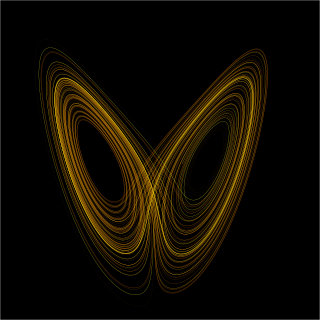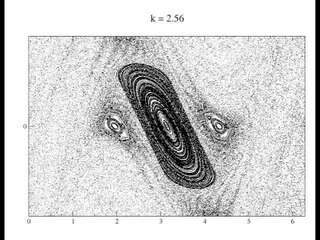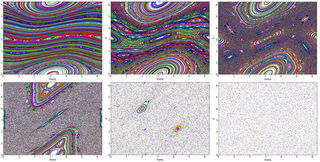
Chaos theory is an interdisciplinary area of scientific study and branch of mathematics. It focuses on underlying patterns and deterministic laws of dynamical systems that are highly sensitive to initial conditions. These were once thought to have completely random states of disorder and irregularities. Chaos theory states that within the apparent randomness of chaotic complex systems, there are underlying patterns, interconnection, constant feedback loops, repetition, self-similarity, fractals and self-organization. The butterfly effect, an underlying principle of chaos, describes how a small change in one state of a deterministic nonlinear system can result in large differences in a later state. A metaphor for this behavior is that a butterfly flapping its wings in Brazil can cause a tornado in Texas.

Quantum chaos is a branch of physics focused on how chaotic classical dynamical systems can be described in terms of quantum theory. The primary question that quantum chaos seeks to answer is: "What is the relationship between quantum mechanics and classical chaos?" The correspondence principle states that classical mechanics is the classical limit of quantum mechanics, specifically in the limit as the ratio of the Planck constant to the action of the system tends to zero. If this is true, then there must be quantum mechanisms underlying classical chaos. If quantum mechanics does not demonstrate an exponential sensitivity to initial conditions, how can exponential sensitivity to initial conditions arise in classical chaos, which must be the correspondence principle limit of quantum mechanics?
A Hamiltonian system is a dynamical system governed by Hamilton's equations. In physics, this dynamical system describes the evolution of a physical system such as a planetary system or an electron in an electromagnetic field. These systems can be studied in both Hamiltonian mechanics and dynamical systems theory.

The Budker Institute of Nuclear Physics (BINP) is one of the major centres of advanced study of nuclear physics in Russia. It is located in the Siberian town Akademgorodok, on Academician Lavrentiev Avenue. The institute was founded by Gersh Budker in 1959. Following his death in 1977, the institute was renamed in honour of Budker.

Yakov Grigorevich Sinai is a Russian–American mathematician known for his work on dynamical systems. He contributed to the modern metric theory of dynamical systems and connected the world of deterministic (dynamical) systems with the world of probabilistic (stochastic) systems. He has also worked on mathematical physics and probability theory. His efforts have provided the groundwork for advances in the physical sciences.
In physics, thermalisation is the process of physical bodies reaching thermal equilibrium through mutual interaction. In general, the natural tendency of a system is towards a state of equipartition of energy and uniform temperature that maximizes the system's entropy. Thermalisation, thermal equilibrium, and temperature are therefore important fundamental concepts within statistical physics, statistical mechanics, and thermodynamics; all of which are a basis for many other specific fields of scientific understanding and engineering application.

A dynamical billiard is a dynamical system in which a particle alternates between free motion and specular reflections from a boundary. When the particle hits the boundary it reflects from it without loss of speed. Billiards are Hamiltonian idealizations of the game of billiards, but where the region contained by the boundary can have shapes other than rectangular and even be multidimensional. Dynamical billiards may also be studied on non-Euclidean geometries; indeed, the first studies of billiards established their ergodic motion on surfaces of constant negative curvature. The study of billiards which are kept out of a region, rather than being kept in a region, is known as outer billiard theory.
In physics, mechanics is the study of objects, their interaction, and motion; classical mechanics is mechanics limited to non-relativistic and non-quantum approximations. Most of the techniques of classical mechanics were developed before 1900 so the term classical mechanics refers to that historical era as well as the approximations. Other fields of physics that were developed in the same era, that use the same approximations, and are also considered "classical" include thermodynamics and electromagnetism.
Nikolay Sergeevich Krylov was a Soviet theoretical physicist known for his work on the problems of classical mechanics, statistical physics, and quantum mechanics. He showed that a sufficient condition for a dynamical system to relax to equilibrium is for it to be mixing.

The standard map is an area-preserving chaotic map from a square with side onto itself. It is constructed by a Poincaré's surface of section of the kicked rotator, and is defined by:

Iosif Benzionovich Khriplovich was a Russian theoretical physicist who made profound contributions to quantum field theory, atomic physics, and general relativity.
The Chirikov criterion or Chirikov resonance-overlap criterion was established by the Russian physicist Boris Chirikov. Back in 1959, he published a seminal article, where he introduced the very first physical criterion for the onset of chaotic motion in deterministic Hamiltonian systems. He then applied such a criterion to explain puzzling experimental results on plasma confinement in magnetic bottles obtained by Rodionov at the Kurchatov Institute.

George M. Zaslavsky was a Soviet mathematical physicist and one of the founders of the physics of dynamical chaos.

The kicked rotator, also spelled as kicked rotor, is a paradigmatic model for both Hamiltonian chaos and quantum chaos. It describes a free rotating stick in an inhomogeneous "gravitation like" field that is periodically switched on in short pulses. The model is described by the Hamiltonian
Gersh Itskovich Budker, also named Andrey Mikhailovich Budker, was a Soviet physicist born in Murafa in Ukrainian People's Republic, specialized in nuclear physics and accelerator physics.

Edward Ott is an American physicist and electrical engineer, who is a professor at University of Maryland, College Park. He is best known for his contributions to the development of chaos theory.
Ian Colin Percival is a British theoretical physicist. He is the Emeritus Professor of the School of Physics and Astronomy at Queen Mary University, University of London. He is one among the pioneers of quantum chaos and he is well known for his suggestion in the 1970s about the existence of a different type of spectra of quantum-mechanical systems due to classical chaos. Numerical explorations performed by other researchers clearly confirmed this idea later. In 1987, with Franco Vivaldi, he used the algebraic number theory of quadratic number fields to count the periodic orbits in generalized Arnold-Sinai cat maps. Later on, he worked on the basics of quantum mechanics and the measurement process. Together with Walter Strunz, he suggested the properties of the quantum foam at the Planck scale in the wave function of an atom-beam interference.
Giulio Casati is Emeritus Professor of Theoretical Physics at University of Insubria. Casati is known for his work on chaos, both classical and quantum, being considered one of the pioneers of the latter. Casati is in fact principally known for the discovery of quantum dynamical localization phenomenon, that highlighted the relevance of chaos in quantum mechanics. His landmark paper, with Boris Chirikov, Joseph Ford and Felix Izrailev, is among the most quoted in the field. With Boris Chirikov, Italo Guarneri and Dima Shepelyansky Casati also discovered that quantum localization deeply affects the excitation of hydrogen atom in strong monochromatic fields. Further major contributions considered the connections between quantization of non integrable systems and the statistical theory of spectra. With the advent of quantum computing Casati and his coworkers studied the efficient quantum computing of complex dynamics. On the classical side, Casati's interests regarded mostly energy conduction in non-linear lattices: from the earliest numerical proof of the validity of Fourier law in one-dimensional many body systems, obtained in collaboration with Bill Wisscher, Franco Vivaldi, and Joseph Ford, to the description of a thermal rectifier and of a thermal transistor. The same techniques lead to the theoretical demonstration of a one-way mirror for light

Quantum thermodynamics is the study of the relations between two independent physical theories: thermodynamics and quantum mechanics. The two independent theories address the physical phenomena of light and matter. In 1905, Albert Einstein argued that the requirement of consistency between thermodynamics and electromagnetism leads to the conclusion that light is quantized, obtaining the relation . This paper is the dawn of quantum theory. In a few decades quantum theory became established with an independent set of rules. Currently quantum thermodynamics addresses the emergence of thermodynamic laws from quantum mechanics. It differs from quantum statistical mechanics in the emphasis on dynamical processes out of equilibrium. In addition, there is a quest for the theory to be relevant for a single individual quantum system.
DmitriiValerevich Treschev is a Russian mathematician and mathematical physicist, specializing in dynamical systems of classical mechanics.












